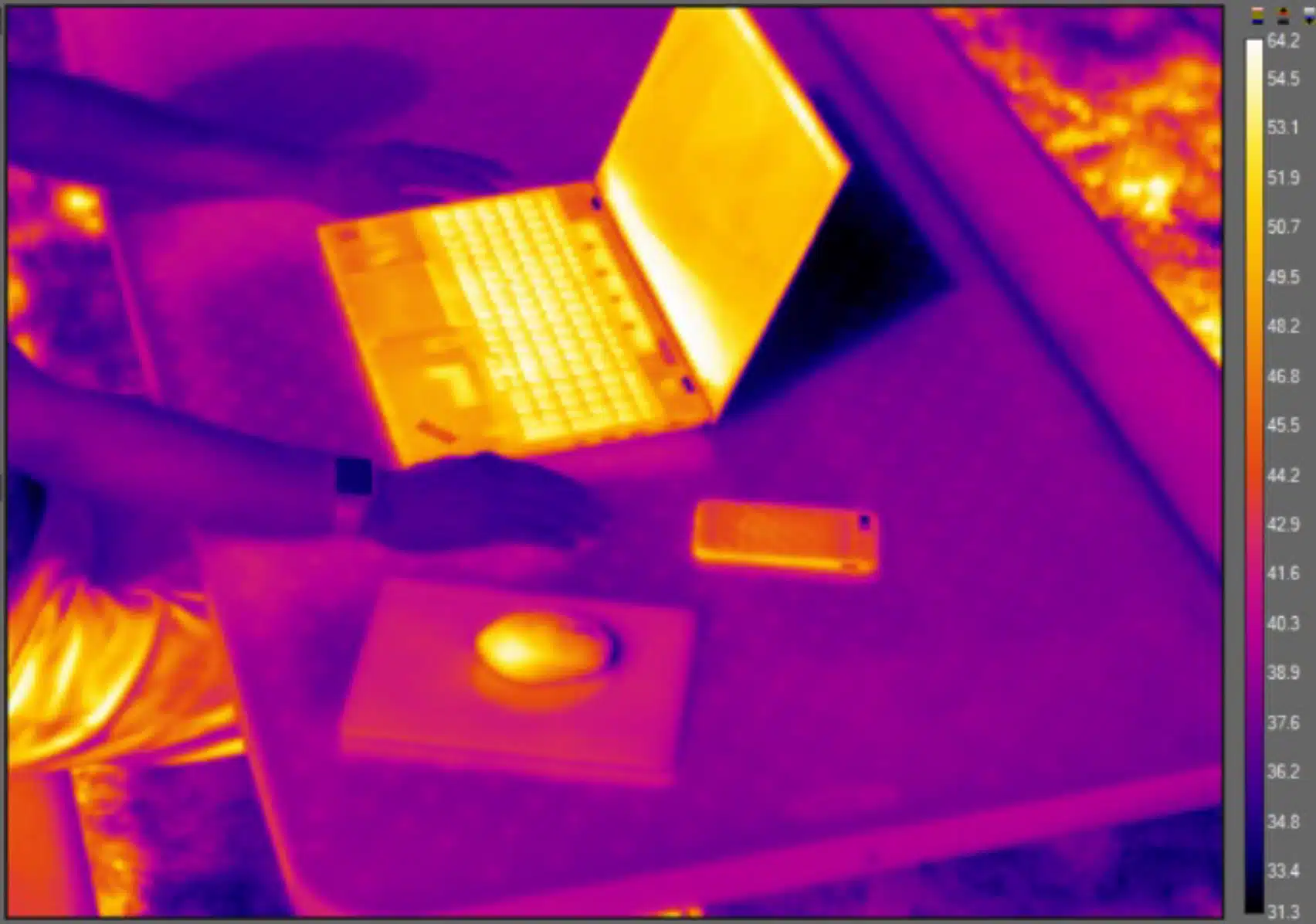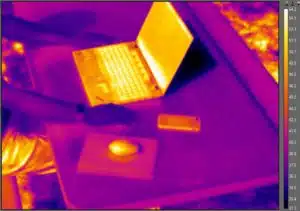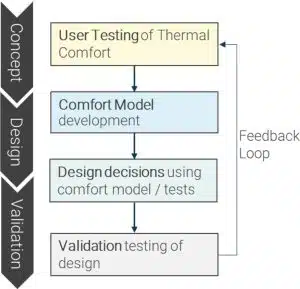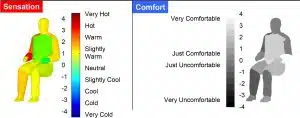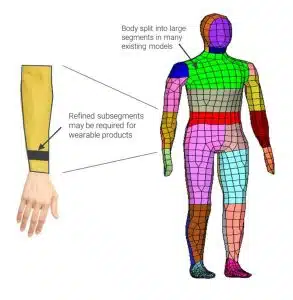Written by: Mark Hepokoski, ThermoAnalytics and Alex Ockfen, Meta Reality Labs
Introduction
ASHRAE defines thermal comfort as “that condition of mind that expresses satisfaction with the thermal environment” [1]. While engineers and designers are typically familiar with the thermal safety and compliance standards required in their industry [2], thermal comfort is less well understood and often treated as an afterthought in the design process. However, thermal comfort should be considered early in any product development process. Not only are thermal comfort thresholds lower than their safety counterparts, but thermal comfort-related misses can hinder the success of a design due to factors such as poor product reviews.
As illustrated in Figure 1, the human body is often cooler than commercial electronic items, such as laptops or mobile phones. If the heat flux resulting from immediate and/or prolonged contact with an electronic device negatively impacts comfort, satisfaction with the product will consequently also be negatively affected. In light of this, comfort in the consumer electronics industry is expected to become increasingly important as people become more directly coupled with their electronics devices. This primarily is being observed in the wearables industry with devices such as smartwatches, virtual reality, and augmented reality products.
Figure 1: Infrared image of common consumer electronics during outdoor usage (°C)
Thermal comfort is a complex phenomenon that depends on factors including personal preference, local environment, geographical location, product use case, product type, user interface, geometry, and material to name a few. The wide range of contributing factors results in a large variation in thermal comfort metrics and indicators, including temperature, heat flux, and skin wettedness. Table 1 provides a non-exhaustive snapshot of various comfort limits identified in the literature. It is also possible that there are interactions between multiple metrics, such as temperature and skin wettedness.
|
Table 1: Examples of Thermal Limits for Comfort and Safety |
|||
|
Thermal Limits |
Limit Type |
Value |
Ref. |
|
Safety |
Touch Temperature (> 8hr) |
43°C |
[2] |
|
Touch Temperature (> 1min) |
48°C |
||
|
Comfort |
Touch Temperature* |
40-48°C |
[3] |
|
41°C |
[4] |
||
|
44°C |
[5] |
||
|
45°C |
[6] |
||
|
Heat Flux |
400 W/m2 |
[4] |
|
|
Skin Wettedness |
0.30-0.36 |
[7] |
|
|
* Touch temperature limits typically correspond to the initial onset of pain/discomfort, not the first thermal sensation |
Given both the importance and complex nature of thermal comfort in electronics design, a logical process is needed to design for thermal comfort. Successful design typically combines user testing and comfort modeling to enable data-driven design decisions. Figure 2 illustrates one embodiment of a notional process for integrating thermal comfort into the design cycle.
Figure 2: Integrating thermal comfort into the design process
User Testing
Thermal sensation is affected by warm and cold subcutaneous thermo-receptor discharge rates, which, in turn, are correlated with human body temperature [8]. Understanding how hot or cold stimuli may be perceived by a human subject requires a comprehensive assessment of the heat generated and distributed within a human body and the heat transfer between the body and its environment. Thermal perception can be described in terms of thermal sensation (how hot or cold one feels) and/or thermal comfort (whether or not the sensation feels good or bad) [9][10].
In addition to thermo-receptors, “touch” receptors may also be important in thermal perception studies. For example, cool air impinging on human skin can cause so-called draft discomfort, which correlates to the response of both mechanoreceptors and thermo-receptors when stimulated in tandem [11]. For example, draft discomfort is a significant concern in the design of architectural and automotive environments since climate control systems typically rely on air movement to modulate the ambient temperature. Similarly, the combination of these same receptor responses, when processed in the brain, elicits the perception of wetness. This may cause discomfort during an exposure in which sweat is produced and leads to an uncomfortable feeling of stickiness after the sweat has dried [12]. Wetness and stickiness should be considered in thermal perception studies involving warm to hot environments and/or work-rest cycles incorporating high activity.
While there is a clear correlation between thermo-physiological state and thermal perception within an average population subgroup, there will always be variability among individuals [13]. While a portion of this variability can be attributed to differences in individual subjective thermal preferences, other, more objective factors that influence thermo-physiological state, can be controlled to some extent. If one of the objectives of a test is to reduce variability, it is important to define a test protocol that ensures all participants are outfitted in a standardized clothing ensemble (e.g., jeans and t-shirt) and perform the same activity (e.g. a prescribed work-rest cycle). The initial thermo-physiological state can strongly impact test results [14]. This influence can be mitigated by ensuring that test participants control their activity prior to testing by, for example, requiring that they refrain from vigorous exercise a sufficient number of hours before the testing. Some aspects may be more challenging to control, but can nevertheless be addressed by using a larger study population so that test data can be segregated and analyzed a postiori according to subgroups of individuals that share the same personal characteristics, such as ethnicity, sex, levels of acclimatization, and physical fitness.
Subjective responses can be gathered by a variety of means, including by the use of paper or electronic forms filled out by test participants throughout the exposure [15]. Participants can also be prompted intermittently to provide a verbal description of their thermal state [16]. While such an approach can be labor-intensive, it does provide a more natural experience for the test participant and can improve reliability and consistency in test results.
For most applications, overall thermal comfort is the primary metric that ultimately needs to be gathered from a test. However, for a deeper understanding of how the participant’s thermophysiological state may be influencing comfort, it can be valuable to also obtain a measure of the participant’s overall thermal sensation. Additionally, since overall comfort correlates well with the comfort of the two most uncomfortable body segments, it can be informative to have test participants identify these along with the local sensation and comfort of these segments. It is critical that wetness perception and air movement/draft perception are measured if sweating or air movement are likely to occur during the exposure.
The psychology of an individual can also bias results. Studies have shown that thermal perception can be influenced by the color of a room or whether one has control over the environment. To mitigate such influences, the test should be designed to obfuscate the experimental setup details or its history and reduce bias derived from one’s emotional state or perception of personal appearance as well as distracting factors such as wires for data acquisition devices or instrumentation.
When comfort testing focuses on a device or product, it is important to consider the value proposition that the device provides the user. In some cases, the value of the device may influence the user’s comfort threshold or thermal acceptability of the device.
Comfort Models
Accurate assessment of thermal perception requires a comprehensive analysis of the heat transfer between the human body and the environment. A conventional prediction approach (e.g. PMV/PPD, Equivalent Temperature) is to directly correlate thermal perception to environmental conditions (e.g. air temperature, clothing), which implicitly accounts for the relationship between physiological state and thermal comfort [17][18][19]. An alternate approach (e.g. the Berkeley Comfort Model, Fiala DTS) is to explicitly correlate thermal perception to physiological state (e.g. skin and core temperature), thereby separating the objective thermal analysis portion of the problem from the subjective thermal perception analysis side [9][20][21][22][23].
Thus, thermal comfort models can be categorized as either environment-based [Table 2] or physiology-based [Table 3]. Environment-based models typically require inputs of air and surrounding temperatures, air velocity, clothing thermal resistances, humidity, and solar loading. Physiology-based comfort models just require inputs of the human body’s thermal state, usually in terms of skin temperature, core temperature, evaporation rate, and the rates of change of skin and core temperatures.
|
Table 2: Examples of Environment-based Comfort Models |
|
|
Environment-based Models |
Publication |
|
Predicted Mean Vote (PMV) |
Fanger 1970 |
|
Predicted Percent Dissatisfied (PPD) |
Fanger 1982 |
|
Equivalent Temperature (EHT) |
Wyon et al., 1989 |
|
Table 3: Examples of Physiology-based Comfort Models |
|
|
Physiology-based Models |
Publication |
|
Skin Wettedness Comfort (wsk) |
Gagge, 1967 |
|
Dynamic Thermal Sensation (DTS) |
Fiala et al., 2003 |
|
Berkeley Comfort Model (BCM) |
Zhang et al., 2009 |
Figure 3: Berkeley Comfort Model sensation and comfort
Fanger developed the Predicted Mean Vote (PMV) model and its associated Predicted Percentage of Dissatisfied (PPD) model to predict thermal sensation and the level of discomfort of human subjects in different steady environmental conditions and at various activity levels. Fanger’s model is a function of activity level, clothing resistance, air temperature, mean radiant temperature, air velocity, and relative humidity.
Fiala’s Dynamic Thermal Sensation (DTS) model is derived from correlations of thermal sensation with mean skin temperature, core temperature, and the time derivative of mean skin temperature. In contrast to PMV, the DTS model can be used to predict thermal sensation in transient conditions. Both PMV and DTS report thermal sensation on the ASHRAE seven-point scale in which +3 is hot, 0 is neutral and -3 is cold. The output from either model can be supplied to Fanger’s PPD model to predict (dis)satisfaction with the thermal environment (i.e., thermal comfort), provided that conditions are both steady and homogeneous.
The Berkeley Comfort Model is widely considered the state of the art for predicting thermal perception from body core and skin temperatures in transient and asymmetric conditions. Overall and local (per segment) thermal sensation and comfort are reported on a pair of 9-point scales. The sensation scale has the same interpretation as the ASHRAE 7-point scale, but includes the extreme sensations of “very hot” and “very cold.” A separate scale is used to indicate various levels of comfort; positive values indicating satisfaction and negative values corresponding to dissatisfaction.
Environment-based comfort models can be adequate for predicting comfort for individuals undertaking sedentary or low activity work for extended periods in traditional office building environments. Physiology-based comfort models, on the other hand, are needed to predict the comfort of individuals exposed to transient and asymmetric loading scenarios, or exposures in which an individual’s anthropometry, physiology, or initial thermo-physiological state, play a role.
It is important to note that physiology-based comfort models must be used in conjunction with a high-resolution human thermal model that considers passive and active thermoregulation [24]. Metabolism, shivering, sweating, and changes in skin blood flow (vasomotion) must be modeled, often on a regional basis, so that human core and skin temperature distributions can be properly rendered before being input to a thermal comfort model.
Integration in the Electronics Cooling Community
Physiology-based models are especially useful for predicting thermal perception within scenarios involving contact surfaces, such as a person occupying a heated and cooled seat, interacting with a consumer electronics device, or wearing clothing with passive or active heating and cooling technologies.
These models have found wide adoption in the automotive and architectural worlds. Many have been incorporated within standard heat transfer modeling tools. To better address the needs of the electronics cooling industry, the focus has recently shifted toward extending these models to accommodate comfort prediction for more localized heating effects. There are existing gaps and research areas that are actively being explored, such as the development of sub-segment models [Figure 4], accounting for ethnicity and psychology, and providing further physiologic and anthropometric resolution within the human body.
Figure 4: Sub-segment comfort zones
While a wearable electronic device may not significantly impact one’s overall thermo-physiological state, it can significantly impact local thermal perception and lead to strong overall thermal comfort or discomfort, despite having limited contact with the body. Thermal discomfort surprises can be avoided through the integration of user comfort testing and physiology-based modeling into the standard design process for wearable electronics.
References
[1] ASHRAE Standard 55, “Thermal environmental conditions for human occupancy,” American Society of Heating, Refrigeration, and Air-Conditioning Engineers, 2010.
[2] IEC 62368-1, “Audio/video, information and communication technology equipment – Part 1: Safety requirements,” International Electrotechnical Commission, 2018.
[3] Defrin R., Ohry A., Blumen N., and Urca G., “Sensory determinants of thermal pain,” Brain, 2002.
[4] Griffith J., Hamilton A., et al., “Human skin temperature response to absorbed thermal power,” Proc. SPIE 3037, Medical Imaging 1997.
[5] Ungar E., Stroud K., “A new approach to defining human touch temperature standards,” 40th International Conference on Environmental Systems, 2010.
[6] ASHRAE Fundamentals, “Chapter 9: thermal comfort,” American Society of Heating, Refrigeration, and Air-Conditioning Engineers, 2017.
[7] Fukazawa T., Havenith H., “Differences in comfort perception in relation to local and hwole-body skin wettedness,” Journal of Applied Physiology, 2009.
[8] Ring J., de Dear R., “Temperature transients: a model for heat diffusion through the skin, thermoreceptor response and thermal sensation,” Indoor Air. 1991;1:448–456.
[9] Gagge A.P., Stolwijk J.A., Hardy J.D., “Comfort and thermal sensations and associated physiological responses at various ambient temperatures.” Environmental Research 1: 1 – 20. 1967.
[10] Schweiker M., Andre M., Al-Atrash F., Al-Khatri H., et al., “Evaluating assumptions of scales for subjective assessment of thermal environments – Do laypersons perceive them the way, we researchers believe?” Energy and Buildings, 211, 2020.
[11] Fanger, P.O., Melikov, A.K., Hanzawa, H., and Ring, J., “Turbulence and draft.” ASHRAE Journal 31(4):18-25. 1989.
[12] Filingeri, D., Havenith, G., “Human skin wetness perception: psychophysical and neurophysiological bases,” Temperature, 2:1, 86-104. 2015.
[13]Schweiker M., Huebner, G., Kingma, B., Kramer, R., and Pallubinsky, H., “Drivers of diversity in human thermal perception – A review for holistic comfort models,” Temperature (Austin) 2018; 5(4): 308–342. 2018.
[14] Hepokoski, M., Curran, A., and Schwenn, T., “A Comparison of Physiology-Based Metrics to Environment-Based Metrics for Evaluating Thermal Comfort,” SAE Technical Paper 2013-01-0844, 2013.
[15] ISO 14505-3:2006, “Ergonomics of the thermal environment — Evaluation of thermal environments in vehicles — Part 3: Evaluation of thermal comfort using human subjects,” International Organization for Standardization, Geneva, 2006.
[16] Hepokoski, M., Patterson, S., Curran, A., Adelman, S. et al., “Evaluating a Heavy-Duty Truck Climate Control System Using Thermal Comfort-Focused Testing and Simulation Techniques,” SAE Technical Paper 2019-01-0696, 2019.
[17] Fanger, P.O., “Thermal comfort analysis and applications in environmental engineering.” McGraw-Hill, New York. 1970.
[18] Fanger, P.O., “Thermal comfort.” Robert E. Krieger, Malabar, FL. 1982.
[19] Wyon, D. P., S. Larsson, et al., “Standard Procedures for Assessing Vehicle Climate with a Thermal Manikin.” SAE Technical Paper Series 890049: 1-11. 1989.
[20] Zhang H., E. Arens, C. Huizenga, and T. Han, “Thermal sensation and comfort models for non-uniform and transient environments: Part I: Local sensation of individual body parts.” Building and Environment, 2009.
[21] Zhang H., E. Arens, C. Huizenga, and T. Han. “Thermal sensation and comfort models for non-uniform and transient environments: Part II: Local comfort of individual body parts.” Building and Environment, 2009.
[22] Zhang H., E. Arens, C. Huizenga, and T. Han. “Thermal sensation and comfort models for non-uniform and transient environments: Part III: Whole-body sensation and comfort.” Building and Environment, 2009.
[23] Fiala, D., Lomas, K.J., Stohrer, M. “First Principles Modeling of Thermal Sensation Responses in Steady–State and Transient Conditions.” ASHRAE Transactions, Volume 109, Part 1. 2003.
[24] Hepokoski, M., Gibbs, S. and Curran, A., “A new anatomical and thermophysiological description of a 50th percentile adult western male,” Digital Human Modeling (DHM2016) Symposium, Montreal (2016).
